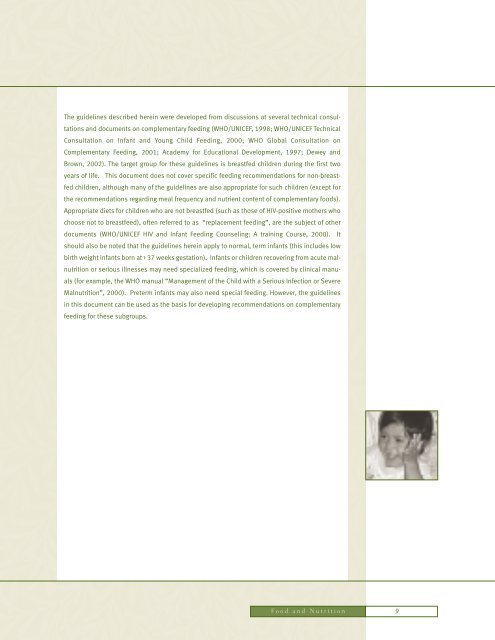Guiding Principles for Complementary Feeding of the Breastfed
Guiding Principles for Complementary Feeding of the Breastfed
Guiding Principles for Complementary Feeding of the Breastfed
You also want an ePaper? Increase the reach of your titles
YUMPU automatically turns print PDFs into web optimized ePapers that Google loves.
The guidelines described herein were developed from discussions at several technical consultations<br />
and documents on complementary feeding (WHO/UNICEF, 1998; WHO/UNICEF Technical<br />
Consultation on Infant and Young Child <strong>Feeding</strong>, 2000; WHO Global Consultation on<br />
<strong>Complementary</strong> <strong>Feeding</strong>, 2001; Academy <strong>for</strong> Educational Development, 1997; Dewey and<br />
Brown, 2002). The target group <strong>for</strong> <strong>the</strong>se guidelines is breastfed children during <strong>the</strong> first two<br />
years <strong>of</strong> life. This document does not cover specific feeding recommendations <strong>for</strong> non-breastfed<br />
children, although many <strong>of</strong> <strong>the</strong> guidelines are also appropriate <strong>for</strong> such children (except <strong>for</strong><br />
<strong>the</strong> recommendations regarding meal frequency and nutrient content <strong>of</strong> complementary foods).<br />
Appropriate diets <strong>for</strong> children who are not breastfed (such as those <strong>of</strong> HIV-positive mo<strong>the</strong>rs who<br />
choose not to breastfeed), <strong>of</strong>ten referred to as “replacement feeding”, are <strong>the</strong> subject <strong>of</strong> o<strong>the</strong>r<br />
documents (WHO/UNICEF HIV and Infant <strong>Feeding</strong> Counseling: A training Course, 2000). It<br />
should also be noted that <strong>the</strong> guidelines herein apply to normal, term infants (this includes low<br />
birth weight infants born at > 37 weeks gestation). Infants or children recovering from acute malnutrition<br />
or serious illnesses may need specialized feeding, which is covered by clinical manuals<br />
(<strong>for</strong> example, <strong>the</strong> WHO manual “Management <strong>of</strong> <strong>the</strong> Child with a Serious Infection or Severe<br />
Malnutrition”, 2000). Preterm infants may also need special feeding. However, <strong>the</strong> guidelines<br />
in this document can be used as <strong>the</strong> basis <strong>for</strong> developing recommendations on complementary<br />
feeding <strong>for</strong> <strong>the</strong>se subgroups.<br />
Food and Nutrition<br />
9

















